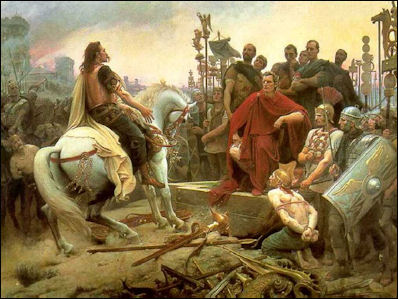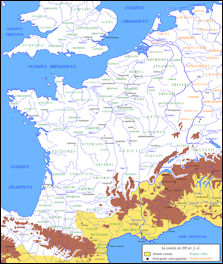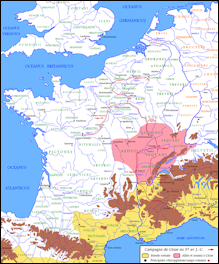Home | Category: Roman Empire and How it Was Built
EARLY BATTLES WITH THE CELTS AND THE COLONIZATION OF FRANCE

Vercingetorix and Caesar after the Siege of Alesia The Celts lost a crucial battle to the Romans in Telamon, Italy in 225 B.C. Even though the Celts effectively used guerilla tactics against the Romans and captured a Roman consul and waved his head on stake, their unruly hand-to-hand tactic were no match against the spears and disciplined ranks of the Romans.
In their accounts of the Celts the Romans described bloodstained Druid alters and mass human sacrifice. They were appalled by this even though they held sporting event in which 5,000 wild animals were killed and gladiators fought each other to the death. "Some of the tribes mae colossal wickerwork figures," Caesar wrote of the Gauls, "the limbs of which are filled with living men: these images are then set alight and the victims perish in the flames."
The Romans consolidated small Celtic and Teutonic kingdoms into an imperial province.The south of France was annexed by the Romans about 125 B.C. and today contains many theaters, amphitheaters, aqueducts, roads, arches, monument, mosaics and artifacts as reminders of its long Roman occupation. When Julius Caesar did his conquering it was primarily to claim northern France for Rome.
The Romans relied on native aristocrats to administer local governments. Many Gauls became citizens of Rome. Gallic silver, glass, pottery, food and wine were exported to Italy. At a factory near Milay in the massif Central, for example, slaves mass-produced pottery for the western half of the Roman Empire, including the entire Roman army.” [Source: Elaine Sciolino. New York Times, May 17, 2009]
Websites on Ancient Rome: Internet Ancient History Sourcebook: Rome sourcebooks.fordham.edu ; Internet Ancient History Sourcebook: Late Antiquity sourcebooks.fordham.edu ; BBC Ancient Rome bbc.co.uk/history; Perseus Project - Tufts University; perseus.tufts.edu ; Lacus Curtius penelope.uchicago.edu; The Internet Classics Archive classics.mit.edu ; Bryn Mawr Classical Review bmcr.brynmawr.edu; Cambridge Classics External Gateway to Humanities Resources web.archive.org; Ancient Rome resources for students from the Courtenay Middle School Library web.archive.org ; History of ancient Rome OpenCourseWare from the University of Notre Dame web.archive.org ; United Nations of Roma Victrix (UNRV) History unrv.com
Caesar in Gaul (France)
Caesar's greatest military victory was the conquest of Gaul (France) in which 55,000 Romans battled 250,000 Celts in a campaign that lasted from 58 to 51 B.C. His account of the events — “Commentaries on the Gallic War” — is still regarded as a masterpiece. Modern historians have compared it to Churchill’s work.
In 58 B.C., after serving a year as consul, Caesar had himself named the governor of Gaul, where he distinguished himself as a superb organizer and a motivator of soldiers with whom he worked with, fought with and suffered with. He inspired such respect and affection from the men who served under him it was said they would do anything for him.

Beginning of Roman advance
into Gaul in 59 BC To protect his army of 40,000 men from the Gauls Caesar erected a fortress with a circumference of 14 miles. The fort was protected by hidden pit with upward pointing sticks, logs spiked with iron hooks, walls fashioned from forked timbers and double ditches. During one attack Celts hurled themselves bravely and foolishly at the fortress and were routed after the Roman cavalry charged down from a hill at a strategic time.
During his years in Gaul Caesar inexorably expanded Roman territory by defeating one tribe after another. He crossed the Rhine in 55 B.C. to preempt a German invasion. In 52 B.C., he put down the last great Gallic-Celtic uprising. Vercingetorix, the leader of the Gallic-Celtic forces, surrendered himself at the feet of Caesar who sent him to Rome where the Gallic leader was imprisoned for six years and then paraded through the streets and strangled in the Forum.
The historian Ernst Badian told National Geographic, "Blood was the characteristic of Alexander's whole campaign. There us nothing comparable in ancient history except Caesar in Gaul."
See Separate Article: JULIUS CAESAR IN GAUL europe.factsanddetails.com
Caesar Makes Rome Into an Empire
Caesar’s campaign in Gaul allowed Rome to claim France, the Netherlands and Belgium. In campaigns early in the Civil Wars period he claimed Portugal, Spain, and Greece. With Egypt under the control of Cleopatra, Caesar set his sights on the Middle East.
After annihilating the Parthians in Pontus and Zela in the Middle East in 47 B.C., Caesar sent home the immortal message, "”Veni, vidi, vici” ("I came, I saw, I conquered"). This victory allowed him to claim Syria, Israel, and western Turkey. Afterwards he returned home to Rome to fight another rival, Cato, who had gone to North Africa to raise an army to challenge Caesar. That didn’t happen. Instead, Caesar sent his army to Africa and crushed Cato.
In 46 B.C., the last of Pompey’s forces were defeated in Spain. With the civil wars over Caesar was the unchallenged leader of Rome. In the meantime Portugal, Spain, France, the Netherlands Belgium, Italy, Greece, Syria, Israel, western Turkey, and northern Libya were added to Rome under Caesar, making it a truly great empire.
Colonization of Gaul (France)

Gaul in 57 BC (Roman expansion in pink)
After the defeat by Caesar, Celtic culture declined on the European mainland. Their culture mixed with Roman culture. They worshipped their own deities under Roman names. The Romans considered the Gauls to be very superstitious. Frenchmen were created out of the union of Romans and Gauls.
Gaul was systematically romanized after the conquest by Caesar. Roads, aqueducts and cities with baths and theaters were built. The mixing of the Roman language of Latin and local Celtic tongues created the French tongue.
After the Romans defeated the Celts, the Celts had difficulty setting up a government and collecting enough taxes to support a disciplined army. Performing these kinds of tasks was against their nature. Corruption was rampant, land owned by small landowners was seized by the estates of the rich. Third century threats in Gaul resulted in the fortification of towns and villages. [Source: "History of Warfare" by John Keegan, Vintage Books]
The Romans ruled what is now France for more than 500 years. They annexed Provence in 121 B.C. and subdued the Gauls during the Gallic Wars between 58 and 51 B.C. Gaul became part of the Roman empire when Julius Caesar defeated Vercingetorix in 52 B.C. The first assembly of Gauls was held in A.D. 12. The Romans founded numerous cities and towns that remain today, including Arles, Lyon, Autun, Frejus, Orange, Nimbe, Narbonne and Vienne.
Battles with German Tribes

Gaul in 51 BC The land of fierce German tribes was held for only about 20 years under the reign of Augustus. German tribes frequently raided towns in Gaul near the border. The land, divided among several German tribes, was lost when three Roman legions were slaughtered at Teutoburg Forest in A.D. 9.
A Roman army under Quictilius Varus was sent in to quell the Germanic tribes but it marched right into a trap. The Battle of Arminius in the Teutoburg Forest brought the Roman expansion into Germany to a halt. Almost every member of a 50,000-member Roman army led by Varus was killed or enslaved. Varus committed suicide.
The defeat kept Rome from absorbing German territory. The Germans captured the Roman standards. Augustus was so upset he didn’t shave and let hair grow for months. He reportedly also banged his head against a wall, shouting, "Varus! Give me back my legions.”
The finality of this battle was called into question when evidence another battle between Romans and Germanic tribes was found in 2006 in a wooded region between Hanover and Kassel deep inside what is now Germany that took place 200 years after the Teutoburg Forest Battle. Some historians have speculated that battle might have occurred after a Roman raid deep inside German territory.
Image Sources: Wikimedia Commons, The Louvre, The British Museum
Text Sources: Internet Ancient History Sourcebook: Rome sourcebooks.fordham.edu ; Internet Ancient History Sourcebook: Late Antiquity sourcebooks.fordham.edu ; “Outlines of Roman History” by William C. Morey, Ph.D., D.C.L. New York, American Book Company (1901) ; “The Private Life of the Romans” by Harold Whetstone Johnston, Revised by Mary Johnston, Scott, Foresman and Company (1903, 1932); BBC Ancient Rome bbc.co.uk/history/ ; Project Gutenberg gutenberg.org ; Metropolitan Museum of Art, National Geographic, Smithsonian magazine, New York Times, Washington Post, Los Angeles Times, Live Science, Discover magazine, Archaeology magazine, Reuters, Associated Press, The Guardian, AFP, The New Yorker, Wikipedia, Encyclopædia Britannica, Encyclopedia.com and various other books, websites and publications.
Last updated October 2024
